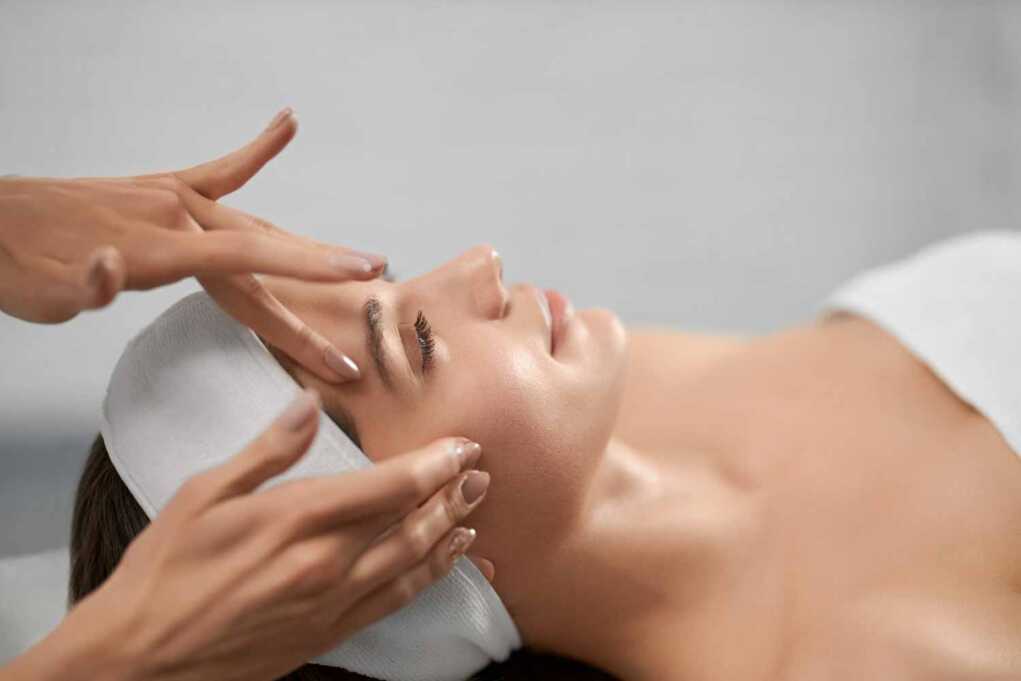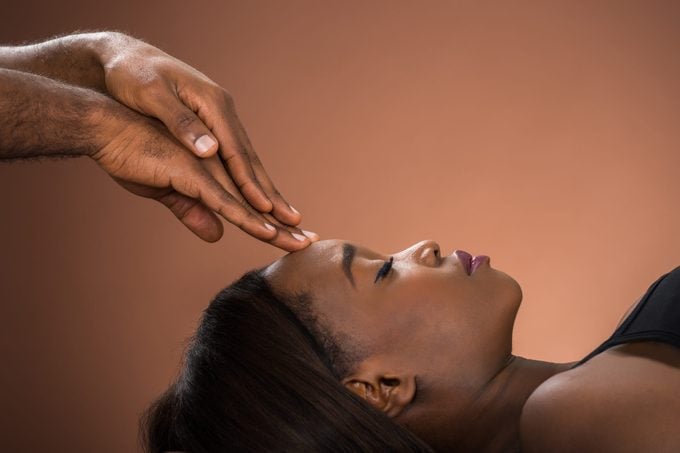
Facial reflexology is an alternative medicine treatment that proponents claim can heal many parts of the body. Here’s what the science says, and whether it’s worth trying.
Facial Reflexology 101
This ancient practice sure sounds nice: A practitioner gently massages and applies steady pressure to key parts of your face. The idea is that it can offer health benefits or even heal what ails you.
Although this alternative medicine treatment has a history dating back thousands of years, many of the supposed health benefits don’t have the research to back up the claims. That said, it may not be a bad thing to give it a shot as long as you know what facial reflexology can and can’t do (and again, a face massage is pleasant enough). Here’s what you need to know.
What Is Facial Reflexology?
Reflexology is based on the concept that areas of the body correspond with different organs and body systems. It focuses on a system of energy lines in the body, which practitioners call meridians. Acupuncturist Tsao Lin Moy, who has more than 18 years of experience as an alternative and Chinese medicine expert, explains that facial reflexology works by applying pressure to areas of the face that correspond with the body’s organs.
Stimulating these reflexology points is thought to affect the brain areas responsible for regulating the corresponding organs, explains Dr. Jacknin. The purpose of facial reflexology is to use these diagnostic points to heal the body.
“Reflexology differs from acupressure and acupuncture in that it uses a mapping of a microcosm of the body on the face, hands, feet, or ears,” Moy says. “What it does have in common with acupressure is massaging an area or point of the body to promote health through the body’s “natural healing mechanism,” Moy says. Acupressure mats are used for similar purposes.
The Two Main Types
Generally speaking, there are a couple of main approaches to facial reflexology: The Dien Chan, created by Dr. Bùi Quôc Châu, and the Sorensensistem Method, created by Lone Sorensen.
Châu’s method was inspired by ear reflexology and traditional Chinese and Vietnamese medicinal systems. In contrast, Sorensen’s method was inspired by neuroanatomy as well as Eastern and South American traditions, according to board-certified dermatologist Jeanette Jacknin, MD, an author, national speaker, and consultant with expertise in holistic dermatology.
What Science Says About Facial Reflexology
Research on facial reflexology is actually more than lacking—it’s almost nonexistent. And what does exist on the topic doesn’t necessarily support reflexology.
Three systematic reviews from 2008, 2009, and 2011 in Leading Global Nursing Research, the Medical Journal of Australia, and Maturiats all found that the current evidence on reflexology available doesn’t support reflexology as an effective treatment for any medical condition.

The Potential Benefits Of Facial Reflexology
There are some theoretical or potential benefits of facial reflexology that are more likely a possibility than others, including stress relief. But these, too, are unsupported by solid scientific research. (Here are the best stress relief toys for adults or kids.)
If you take away the connection to other body parts, facial reflexology could be considered simply a form of facial massage, which has more benefits. Research published in Complementary Therapies in Medicine in 2018 found that face massage may improve blood flow to the face. And in an earlier study, published in 2002 in the International Journal of Dermatology, participants reported feeling fresh and rejuvenated, with suppler skin. (Here are the other benefits of massage.)
One 2015 review article in the Journal of Traditional and Complementary Medicine makes a good point about reflexology. Although many reviews found that strong evidence of reflexology’s positive effects is lacking, small-scale research and anecdotal evidence support its use. Plus, it is a soothing massage, a non-drug complement to treatment, and is risk-free.
Unsupported Claims About Facial Reflexology
Proponents of facial reflexology claim it can improve everything from hormonal health to joint pain. Moy says facial reflexology benefits the stimulation of collagen and increases the circulation of blood. “Stimulating specific points, such as motor points, you tone the facial muscles,” Moy says. “The result is the facial muscles get toned and lifted.”
Research On Other Types Of Reflexology
There is slightly more research on hand and foot reflexology, both of which apply the same reflexology concept to the hands and feet.
According to the National Center for Complementary and Integrative Medicine (NCCIH), a study by the National Cancer Institute found that women with advanced breast cancer who received reflexology treatments showed improvement in a few symptoms, such as shortness of breath. But the treatment didn’t help other symptoms, such as nausea or pain.
Another small amount of research suggests that reflexology might help reduce a burning or prickling sensation sometimes associated with multiple sclerosis. Still, there’s insufficient evidence to fully support the use of reflexology for most multiple sclerosis symptoms, according to the NCCIH.
A 2015 study in the Journal of Traditional and Complementary Medicine found that although there are small-scale trials and anecdotal evidence, strong evidence supporting foot reflexology is lacking. (Here’s why touch might be the most important sense.)
What Are The Risks Of Facial Reflexology?
Reflexology generally appears to be safe, especially since it is noninvasive. According to 2017 research in the Journal of Traditional and Complementary Medicine, as long as necessary precautions are taken with patients with special medical conditions (such as blood clot disorders, cancer, and heart failure), the practice is safe. And in the National Cancer Institute study, the practice was found safe for even the most fragile of cancer patients.
People may experience short-term side effects after treatment, including tenderness or sensitivity in the area that receives treatment, as well as light-headedness.
Can I Do My Own Facial Reflexology?
You can practice facial reflexology by massaging different points on your face, using your fingers and hands. Common pressure points include the forehead, ear, and chin for insomnia; and the center of the forehead for the immune system and the mind, says Dr. Jacknin.
Do I Need Facial Reflexology Tools?
Some proponents of facial reflexology support using facial reflexology tools such as wands, jade rollers, and gua sha tools. Avoid dermarollers, which contain dozens of tiny needles that help products sink deeper and treat skin concerns. These aren’t part of Chinese medicine, Moy says, and may damage the skin.
The Bottom Line
Facial reflexology claims that there’s a pressure point related to almost every health issue and that applying pressure or massage can help the problem. Whether or not practicing facial reflexology actually benefits these issues remains to be seen.
Until additional research is conducted to support the claims of its benefits, consider facial reflexology a fun way to potentially release tension and massage your face—not your first line of defense against health problems.
If you’re interested in trying it out with the help of a professional, opt for a trained reflexologist who has registered with the American Reflexology Certification Board. Or pick up a facial reflexology tool for a DIY approach.
Important Notice: This article was originally published at www.thehealthy.com by Emily DiNuzzo where all credits are due. Medically reviewed by Jessica Wu, MD
Disclaimer
The watching, interacting, and participation of any kind with anything on this page does not constitute or initiate a doctor-patient relationship with Dr. Farrah™. None of the statements here have been evaluated by the Food and Drug Administration (FDA). The products of Dr. Farrah™ are not intended to diagnose, treat, cure, or prevent any disease. The information being provided should only be considered for education and entertainment purposes only. If you feel that anything you see or hear may be of value to you on this page or on any other medium of any kind associated with, showing, or quoting anything relating to Dr. Farrah™ in any way at any time, you are encouraged to and agree to consult with a licensed healthcare professional in your area to discuss it. If you feel that you’re having a healthcare emergency, seek medical attention immediately. The views expressed here are simply either the views and opinions of Dr. Farrah™ or others appearing and are protected under the first amendment.
Dr. Farrah™ is a highly experienced Licensed Medical Doctor certified in evidence-based clinical nutrition, not some enthusiast, formulator, or medium promoting the wild and unrestrained use of nutrition products for health issues without clinical experience and scientific evidence of therapeutic benefit. Dr. Farrah™ has personally and keenly studied everything she recommends, and more importantly, she’s closely observed the reactions and results in a clinical setting countless times over the course of her career involving the treatment of over 150,000 patients.
Dr. Farrah™ promotes evidence-based natural approaches to health, which means integrating her individual scientific and clinical expertise with the best available external clinical evidence from systematic research. By individual clinical expertise, I refer to the proficiency and judgment that individual clinicians acquire through clinical experience and clinical practice.
Dr. Farrah™ does not make any representation or warranties with respect to the accuracy, applicability, fitness, or completeness of any multimedia content provided. Dr. Farrah™ does not warrant the performance, effectiveness, or applicability of any sites listed, linked, or referenced to, in, or by any multimedia content.
To be clear, the multimedia content is not intended to be a substitute for professional medical advice, diagnosis, or treatment. Always seek the advice of your physician or other qualified health providers with any questions you may have regarding a medical condition. Never disregard professional medical advice or delay in seeking it because of something you have read or seen in any website, video, image, or media of any kind. Dr. Farrah™ hereby disclaims any and all liability to any party for any direct, indirect, implied, punitive, special, incidental, or other consequential damages arising directly or indirectly from any use of the content, which is provided as is, and without warranties.








